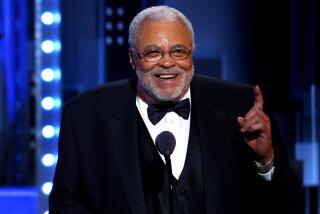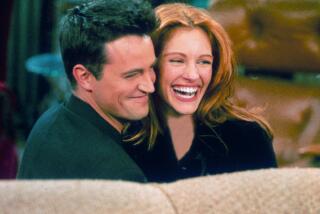Jackie Gleason, ‘Great One’ of Many Talents, Dies at 71
- Share via
Jackie Gleason, the barrel-shaped “Great One” who won television fame and riches as a blustering bus driver in “The Honeymooners,” and an Oscar nomination for his film portrayal of an aging pool shark in “The Hustler,” died Wednesday at his home outside Fort Lauderdale, Fla.
He was 71, and his wife, Marilyn, said cancer was the immediate cause of death. Gleason had been released only last week from Imperial Point Medical Center in Fort Lauderdale, where he had been undergoing treatment.
She said his daughters, Linda Gleason Miller and Geraldine Gleason Chutuk, and his son-in-law, Jack Chutuk, had flown in from California last week to spend Father’s Day with him.
“He had family and close friends in for Sunday,” Mrs. Gleason said. “He was feeling in good spirits Monday and Tuesday. He quietly, comfortably passed away.”
But Gleason had been in poor health for several years, surviving a series of heart bypass operations and complicating recoveries with his ongoing penchant for alcohol, cigarettes and food. He was diagnosed as diabetic three years ago.
Yet when he died--at the suburban home he had furnished with a mammoth wet bar, pool table and other amenities--the career that had commanded salaries commensurate with his girth since the infancy of television was again on the ascent. This latest rise came through reruns of “The Honeymooners”--among the three most popular domestic comedy series in TV history, along with “I Love Lucy” and “All in the Family.”
It was “And Aaawaaaay We Go” all over again for Gleason.
Astute Businessman
Ever the astute businessman, he continued to collect a share of both the original 39 “Honeymooner” episodes he once owned outright and the snippets of the ongoing feud between bus driver Ralph Kramden (Gleason) and his firm but patient wife, Alice (Audrey Meadows) that had been gleaned from Gleason’s variety show.
For a man who disdained his bosses, either in film or television; who drank as much and whenever he pleased to the horror of his doctors and some of his wives, and who splattered his talents across a series of questionable artistic canvases, impaling him on many critical skewers, he had not done badly.
He had written, composed music for and starred in what some ardent admirers believed was one of the most underrated motion pictures of all time (“Gigot”); had portrayed a series of characters on television ranging from the outrageously obnoxious Kramden to the mutely pathetic “Poor Soul,” and had been seen in films as Minnesota Fats in “The Hustler” and Sheriff Buford T. Justice in the “Smokey and the Bandit” series co-starring Burt Reynolds and an assortment of wrecked automobiles.
Albums Sold Millions
His albums of mood music, many adorned with original Salvador Dali paintings as covers, had sold in the millions.
He was a fat man who never worried about being fat, an extrovert who excelled at pantomime and a musical conductor and composer who couldn’t read a note, yet wrote a theme for his television show that once was as familiar in America as the “Star Spangled Banner.”
His later work may not have justified his title as “The Great One,” a sobriquet reportedly attached to him by Orson Welles, but he was always the mischievous “Entertaining One,” tilting at executive windmills or traveling the nation’s rails in private cars stocked with booze and budding starlets.
Not bad for a stand-up comic who had gotten himself fired the first time he stood up.
First Routine ‘Was Awful’
As he told Morley Safer in a 1984 interview on CBS TV’s “60 Minutes”:
“I was working at this (New York City) club and had gotten through my first routine, which was awful. I was very nervous. . . . The owner brought me over to the bar and told me I was fired. I had about 15 drinks and then went out for my second and what I thought was my last show. This time I was really ‘relaxed’ and very funny and the audience loved me.”
There followed work at the Miami Club in Newark, N.J., where he was both bouncer and master of ceremonies; a stint as a $75-a-week disc jockey in Newark, and then two fruitful years at Club 18 and Leon and Eddie’s in New York City.
On the strength of his club successes, he made his Broadway debut in 1940 in a Shubert production, “Keep Off the Grass,” since forgotten by all but its cast. He also was seen about that same time at Club 18 by film producer Jack Warner, who offered a one-year Hollywood contract.
Back to Broadway
“I got $250 a week for some gangster films (“All Through the Night,” “Larceny Inc.”) and couldn’t wait to get back” to New York, Gleason said years later.
He took his 250 pounds enclosed in natty size-52 suits and brash mannerisms back to Broadway, where he landed parts in the 1943 version of “Artists and Models” and then “Follow the Girls” in 1944. It was at this time that Gleason first ignored advice to lose weight in order to further his career, telling well-meaning friends, “I can get away with more as a fat man.”
“Follow the Girls” ran for 882 performances and Gleason’s portrayal in drag of a Navy WAVE was hailed as one of the brightest spots in the musical. He was hired as a radio replacement for Bob Crosby and then, at a time when he already was earning $1,000 a week at Billy Rose’s Diamond Horseshow club, he entered television.
Destined for Each Other
The infant entertainment medium and the equally bratty comic seemed destined for each other.
He first stepped before a TV camera in 1949 in the televised version of radio’s old “Life of Riley” series. Many believed that the problem-plagued Chester A. Riley--whose response to the fates that plagued him was always: “What a revoltin’ development this is!”--had in him the seeds of bus-driver Kramden.
But his next TV appearances, in 1950-52 as a replacement for Jerry Lester on the old Dumont network’s “Cavalcade of Stars,” was where he actually fathered his mythical offspring. There he introduced the top-hatted playboy Reggie Van Gleason III, The Poor Soul, Joe the Bartender conversing across the bar with Crazy Guggenheim, the oppressed Fenwick Babbitt and “The Loudmouth,” Charlie Bratten.
Most Endearing
The character that was to prove Gleason’s most endearing and lucrative of all made his raucous debut in 1951--Ralph Kramden, victim of both the New York bus system and his oppressed and nagging wife, Alice. In an apartment Alice didn’t often clean, America’s newest and most popular couple exchanged verbal abuse.
Gleason told “60 Minutes” that Alice and Ralph were rooted in his own impoverished Brooklyn childhood.
“My mother always worked. My father left home when I was 8. . . . She was a good mother . . . everything was pleasant, but bare. . . . There were many Kramdens in the neighborhood. . . .”
Gleason failed to add that his mother, who supported herself and Jackie making change in a subway station booth, died when he was 16.
Pert Kelton was the original Alice Kramden when “The Honeymooners” was first aired as an adjunct to the “Cavalcade of Stars” show on the Dumont network. Art Carney was Ed Norton, the inarticulate sewer worker neighbor. Ralph would hatch such hare-brained, get-rich schemes as no-calorie pizza or wallpaper that glowed in the dark, and Norton (never called by his first name) would lend semi-articulate, but fervent, agreement.
$8,000 a Week
“Cavalcade of Stars” proved such a success that in 1952 Gleason was offered a then-staggering $8,000 a week by CBS to leave Dumont. He didn’t hesitate and Ralph and Alice Kramden (now played by Audrey Meadows) and Ed and Trixie Norton (played by Joyce Randolph)--along with Reggie, Joe, Crazy and Fenwick--changed studios, and became part of “The Jackie Gleason Show.”
Under that name, the show ran uninterrupted from 1952 until 1959 and then again from 1962 until 1970. “The Honeymooners”--with Gleason, Meadows, Carney and Randolph--was spun out of the original Gleason show and ran as a separate entity from 1955 to ’56 and again for six months in 1971. (Sheila MacRae played Alice in 1971 and Jane Kean was Trixie that same year.)
The hourlong variety shows were done live before always-enthusiastic audiences with a minimum of rehearsal, while the 30-minute “Honeymooners” was also done before “live” crowds, but filmed for showing later.
Gleason liked to boast that in all those years only the sound of an occasional dropped prop ever marred the performances.
By 1955, Gleason had become “Mr. Saturday Night” and William Paley, head of CBS, was being asked to hike the ante.
Gleason’s multiyear contract had run out and he wanted $11 million to renew. Paley insisted that the negotiations be done face to face.
Into the CBS executive tower strode Gleason, suffering from a monumental hangover.
“I dozed off during the talks,” he told “60 Minutes.” “Paley looked over at me and after a while said ‘If that’s the way he feels, give it to him.’ ”
It wasn’t just the hangover that swung the deal, Gleason claimed. By then he was the toast of the country and CBS was picking up the tabs for the chartered trains he took from New York to Florida, where he played golf.
Asked by “60 Minutes” if it was true that CBS also paid for a bar on the train, Gleason answered: “The train was a bar. When you’ve got good ratings, there’s nothing they don’t provide.”
With Milton Berle and Sid Caesar, Gleason had become the nation’s pre-eminent television comic. But Gleason now wanted both more time for himself and time to pursue the more serious side of his profession.
Dramatic Roles
He put a quick 39 episodes of “The Honeymooners” on film to last a season and began to accept dramatic roles. In 1953, he was seen in “The Laugh Maker” on Studio One and followed that with an acclaimed performance as an unscrupulous politician in “Short Cut.” In 1955, he was Aubrey Piper in a television adaptation of “The Show Off.” And he was featured on “Playhouse 90” as Joe in William Saroyon’s “The Time of Your Life.”
At the height of his television fame he took his train (Gleason always feared air travel) back to Hollywood.
In 1961, he and a young Paul Newman made a film that could have been patterned after Gleason’s boyhood on the streets and in the pool halls of Brooklyn. It was “The Hustler,” and Newman was the young shark eager for a match with Gleason, who portrayed the legendary Minnesota Fats. Gleason was nominated for an Oscar and the film was praised for its air of “spiritual decadence.”
With John Patrick, Gleason fashioned a tale of a mute caretaker in a French boarding house caring for an ailing prostitute and her child. He hired dancer-choreographer Gene Kelly to direct, noting, “Who knows more about movie movement than Kelly?”
‘Gigot’ Heralded, Panned
“Gigot” was heralded both as a paean to Gleason’s pantomime genius and panned as an example of why funnymen should stick to being funny.
Gleason would say only that it was the best film he had ever made.
He reprised Rod Serling’s “Requiem” for the screen (with Anthony Quinn as the prizefighter), and then began a descent into film mediocrity that critics say culminated with the first “Smokey” picture in 1977 and continued with “Sting II” in 1982, “The Toy” a year later and “Nothing In Common” in 1986.
Gleason had moved permanently to Florida by then and refused to be tempted away from his golf or the pool table or dice he could use while standing next to the mammoth bar that dominated the den of his home.
He surfaced for an occasional special with Lucille Ball or Julie Andrews and a reunion of “The Honeymooners” in 1977. In 1983, he made a TV film with Laurence Olivier (“Mr. Helpern and Mr. Johnson”) and his performance was hailed, but only for the actor he might have become.
Married in 1936
His private life was as varied as his weight, which reportedly ranged from 190 to 275 pounds. He married for the first time in 1936 and had two daughters.
That marriage ended in 1969 with a divorce. (Gleason, though not a practicing Catholic, had been born one and he intimated that religion played an important role in the marriage lasting 33 years.)
In 1970, he married Beverly McKittrick. They were divorced in 1974, the same year that he married for the third time.
That marriage was to Marilyn Taylor, sister of June Taylor, who had directed the high-precision yet stylized dancers on Gleason’s old TV show.
He lamented the lack of material available for comics of his genre and even toyed once with a CBS offer to pattern a series on his life. Gleason could score it and write it but who could ever portray the loud-mouthed protagonist?
“Yeah, I guess I’m flamboyant,” he replied during an interview with The Times. “One of the last. If you work at it, you ain’t got it. Anyone in show business who plays ‘humble’ is full of crap. Forty, 50 million people don’t get riveted by ‘humble.’ It would be commercial naivete to think so. You gotta have a pretty good opinion of yourself going in, and I always had that. Always.”
How sweet it was!
More to Read
The complete guide to home viewing
Get Screen Gab for everything about the TV shows and streaming movies everyone’s talking about.
You may occasionally receive promotional content from the Los Angeles Times.






